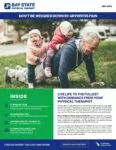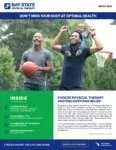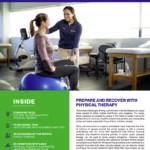When many people think of back pain, they think of just that—pain in the back. But it can also have significant consequences that you may not even be aware of such as headaches, digestive issues, depression, anxiety, fatigue, and immune system dysfunction (you could get sicker, quicker!).
Three Ways Back Pain Can Derail Your Life
Missing days of work due to back pain is common. But many people still go to work to avoid falling behind. The impacts of the underlying pain can drastically affect productivity, as symptoms can be very distracting. According to one survey, chronic back pain contributed to 16.7 minutes per day of work lost to pain. While that might not seem like much, it added up to $1.21 million in lost work for the company surveyed.
- Sleep Interruption- Chronic back pain can significantly disrupt sleep. In addition, more than double the number of people with chronic pain state that their sleep issues interfere with their ability to work effectively, compared to those who don’t experience chronic pain.
- Decline in Overall Health– Pain can limit physical activity, thereby limiting social activity. This can cause people to feel powerless over their pain and negatively impact their overall health. In fact, people with chronic low back pain are four times as likely to suffer from depression. Adherence to exercise is one of the most important factors for long-term pain relief.
- Difficulty Moving Forward– While a typical response to back pain is to take it easy—either staying in bed or at least stopping any strenuous activity—resting for more than a day or two can undermine healing and worsen the pain. And once you stop moving and succumb to the pain, getting the motivation to move again can be difficult.
Take Back Control with Physical Therapy
Non-invasive techniques, such as physical therapy, have been proven to reduce the symptoms of back pain. Based on the success seen in patients, The Agency for Healthcare Research and Quality has recommended that those suffering from low back pain pursue conservative forms of treatment before seeking surgical or medicinal intervention.
The Benefits of Physical Therapy
Physical therapy can give long-term relief from back pain by:
- Increasing strength around the afflicted areas
- Improving mobility and function
- Enhancing endurance and flexibility
- Reducing risk of reinjury
Your physical therapist is your partner in health and will work with you and your other medical providers to ensure you are getting the right services, at the right time during your care.
Here’s What You Can Expect at Physical Therapy
We know it can be intimidating to take the first step toward better health by coming in for a physical therapy appointment. So, if you’ve never attended physical therapy, here’s what you can expect!
Evaluation
To design a personalized treatment program, your physical therapist will:
- Conduct a comprehensive review of your medical history and your current lifestyle
- Assess your symptoms to understand the root cause of your pain
- Measure your range of motion and strength
- Evaluate your posture and the way you move while performing everyday tasks
- Collaborate with you to establish short and long-term goals to work toward during your care
- Answer your questions and put your mind at ease about what to expect on your road to recovery
Personalization
No two people are the same, and neither are the treatment plans to help restore function. Your physical therapist will create a unique and customized plan of care that addresses your weaknesses, your preferred activities, and your baseline pain levels that caused your limitation to begin with. Your physical therapist is your partner in health, putting you at the center of your medical care. Our goal is to empower you to actively contribute to your recovery. In doing so, you will also be prepared to know exactly how to keep up your improved mobility once you ‘graduate’ from physical therapy. This positions you to have all the tools needed to maintain your function well after discharge. Might there be setbacks in the future? Sure, but not to worry, your physical therapist is just a phone call away!
Tools & Treatments
Factoring in what was discovered during your evaluation, your physical therapist will create a treatment plan tailored to your unique needs and goals. This can include:
- Manual therapy techniques such as therapeutic massage, cupping, or dry needling
- Electrical stimulation to relax the areas of muscle pain and spasm to reduce pain
- Exercises to strengthen your core and trunk muscles for better support and decreased stress on your lower back
- Low-impact aerobic exercises (such as stationary biking or water therapy) to increase endurance
- Education on proper body posture and mechanics to reduce strain and decrease the likelihood of reinjury after your discharge from physical therapy
Overcome Back Pain and Return to What You Love
Don’t suffer in silence—let Bay State Physical Therapy help! Using a personalized approach to your wellbeing, physical therapy can significantly improve your pain and function, enhance your body’s ability to heal itself naturally, and get you back to what you love. With locations across much of New England, you can find one of our physical therapy clinics near you by visiting our website!
To learn more, call your nearest Bay State Physical Therapy location or complete the form below to request an appointment.
Resources:
- https://www.dfwback.com/benefits-of-physical-therapy-for-back-pain/
- https://www.medicalnewstoday.com/articles/324174#The-good-news-and-the-bad
- https://www.fernhealth.com/blog/back-pain-in-the-workplace-impacts-employees/
- https://www.spine-health.com/wellness/exercise/exercise-and-back-pain
Tags: trigger point dry needling, pain medications, Physical Therapy, Exercise, Back Pain, Acute back pain, opioids, pain






